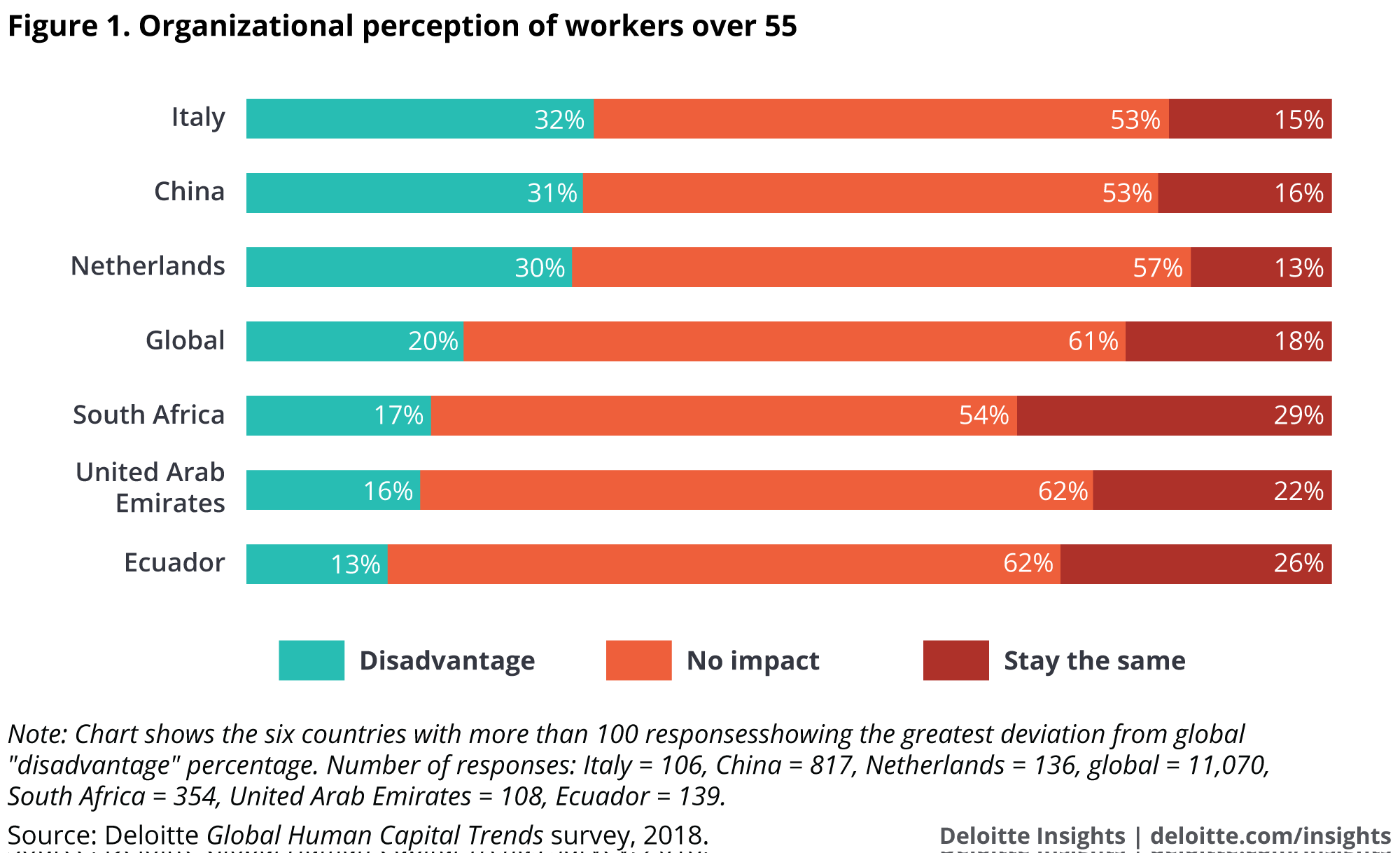The debate about the relationship between employee age and business performance has been going on for ever. But the recent economic turmoil and its after effects on young and old alike have resulted in the topic surfacing again. It’s time to ditch the prejudices.
Employer attitudes can be summarised as:
Younger workers are cheaper to hire, have more up-to-date skills – especially in the area of technology and have more energy and dynamism. They also have lower reliability and significantly less loyalty.
Older workers stick around for much longer than their younger peers. They attain greater mastery of their work and have higher interpersonal skills. But they are also more expensive, less energetic and struggle with today’s technology.
This simplified view distorts the real question. There is no simple correlation between employee age and business performance. Having an older or younger workforce doesn’t automatically make your business perform better or worse. Neither does providing a great working environment result in greater staff loyalty.
The surprising truths about age and employee retention
According to the PayScale report, the Fortune 500 company with the highest median employee tenure (20 years) is Eastman Kodak. More than half of its employees are older than 50. Over the five years through 2012, according to data compiled by Bloomberg, it delivered an average return on assets of negative 12%…
Another myth is that creating a great working environment and culture for staff increases loyalty.
The perks Google lays on for its youthful employees are the stuff of legend. Free gourmet food all day, the best health insurance plan anywhere, five months’ paid maternity leave, kindergartens and gyms at the workplace, the freedom to work on one’s own projects 20 percent of the time, even death benefits. The tech behemoth has topped Fortune Magazine’s list of best companies to work for every year since 2007.
Despite this, Google ranks amongst those with the highest employee turnover rates. The median employee tenure at Google is just over one year, according to the payroll consultancy PayScale.
The simple truths are staring us in the face
So what are businesses to do? If you hire younger people, you are burdened with higher turnover rates. If your workforce is older, you risk stagnation and loss of competitive edge.
A friend of mine, Dean Goranson has provided a valuable perspective which I provide below. It’s a simple tale about his experiences when seeking to get his watch strap repaired.
Here’s Dean’s tale:
A while back I had somehow managed to break the watch band on my high end wrist watch. I finally got tired of running around with it in my pocket, so one day I decided to go down to the mall and check out the jewellery stores to either get it fixed or replaced.
The first store I stopped in, I showed the young lady my watch. She took it to her manager. He asked if I had purchased the watch in their store. I said , ”No”. He replied, “I’m sorry it’s the store’s policy to only work on Items we sell from here.” I then asked, “Isn’t that the style of watch you have in your display case?” “Well yes” was this young man’s reply “but we don’t service anything we haven’t sold. Perhaps you should try that watch band kiosk across from us.” This young manager who must of been well on the south side of thirty was definite in his conviction of his being right. Consumer experience was nowhere to be found on his radar screen. So off to the kiosk to see if I would have any better luck there.
The experience with the young lady who also appeared to be well on the south side of thirty turned out to be quite similar to the first store I had stopped at. I asked if she thought she could fix my watch band. “No, I’m afraid I can’t. We only sell watch bands and put them on for the customer and I don’t have anything that nice. I have an imitation leather if you want me to put that on for you?” I declined and bid her adieu. I really started to feel like this was becoming a quest by this point with no easy answers, yet on I trudged to the next jewellery store.
At the third store I was confronted by another well under thirty something young fella. I showed him the watch and asked if they could fix it “Let me get my manager.” The manager is summoned. Another under 30 something, he takes a look at the watch and say’s “Let’s see what my jeweller can do with this.” so over to the jewellers station we go he looks at it and say’s ” I’m not going to be able to fix this band.” the manager then asks ” Do we have any watch bands in the store to replace this?’ They look and no can do. “Well, I guess we’ll need to call home office to order a replacement.”
The manager asked the jeweller to call home office for the order, the jeweller came back and said he couldn’t get home office on the phone. The manager then asked, “Let me get your phone number and I will call you as soon as I find out something.” At least this young manager was trying to make my experience worthwhile but his operation was in such a state of chaos that he couldn’t make it happen. So off I went disappointed and frustrated.
By now I was a bit dejected at not being able to either get my watch band fixed or replaced.

Walking past the fourth jewellery store, I happened to look in and behind the counter were a couple of ladies. They were well up in age – the grey hair, the glasses and thick figures. I thought to myself what the heck, let’s see if they have any ideas.
Into the store I go and ask these two women, “I’ve got a broken watch band is there anything you can do with it?” “Let me see it,” the white haired gal asked. “We’ve only just started selling this brand of watch; you’ve had yours for a while haven’t you?” “Yes I have.” I could tell in her mind she was fussing over what her next move was going to be. “Let’s take this over to Bill and see what he has to say”.
So over to Bill we go who turns out to be their manager. He too is older and greying. The lady explains the situation to him and asks what they could do to help me. Bill looks at me and says ” Technically I’m not supposed to work on a watch we haven’t sold to a customer, the upper management has the fear we will get sued by someone who claims we broke their stuff.” “You wouldn’t do something like that if I worked on your watch would you?” I said “It’s already broken, what have I got to lose.”
Bill then asks,” Where did your watch fit on your wrist before the band broke?” I showed him and he said “Let me try something.” He took my watch over to another counter and came back in a couple of minutes and said “See if that fits over your hand?” My watch fits better now than it did before I broke the band. Bill even refused to charge for the repair.
A few weeks later it was a good friend’s birthday. And I bought her some diamond earrings. Did I shop around? No I just went straight back to Bill…
Horses for coursesDean’s experience is not research data of course. It’s no more or less than a personal experience. But I am sure it is one that most of us can relate to and have probably shared.
In the effort to improve on profits, what ends up being missed is the consumer experience – the part which keeps the customer coming back for more and recommending the business to others. This hinges on those people the business owner has retained to be the company’s representatives to the public. The higher the quality service the customer receives, the better the results for the business.
As Dean’s story relates, the different levels of service received directly influenced his purchase behaviour now and probably for many years to come. An older employee might be well past the dynamic approach of their youth. But today, youthful distractions are behind them. They have the rich experience of what quality service and customer care really mean.
It seems to me that it’s time to forget the over-simplistic and pointless debate of young versus old. What we need is a simple recognition that age in and of itself is not the issue. Skills and attitudes are what matter. If you want to give your customers excellent service, there is a strong argument for hiring older people. And even if they are slightly more expensive, you’ll recover these costs in longer tenure and enhanced customer loyalty. If you need the sort of perspective that the young have and can afford to replace them frequently, then hire young people. But don’t expect there’s anything you can do to keep them for long.
Let’s not be trapped by the pointless argument about which is better. The key to getting the best business results is about understanding the distinct merits of young and old, making hiring decisions on the value of each and the requirements of the role regardless of the candidate’s age.



















The Australian economy continues to be underpinned by strong population growth, but the data also highlights the increasing divergence between the Australian states.
Population growth remains weak in both South Australia and Tasmania, with both states struggling to attract immigration and capital investment.
The Australian population rose by 1.7 per cent over the year to the March quarter – reflecting strong growth on the east coast – and will continue to underpin real GDP growth for the foreseeable future. Nevertheless, population growth has begun to slow over the past few quarters.
New South Wales and Victoria continue to lead the way, with their populations rising by 1.6 per cent and 1.9 per cent, respectively, over the past year. The population in NSW sits at 7.5 million, and in Victoria at 5.8 million.
But the strongest growth remains in Western Australia. The mining boom might be over, and former mining towns have now become ghost towns, but their populations continues to rise at a rapid pace.
The population in WA rose by 2.5 per cent over the year to the March quarter. This is well down on its peak during the mining boom – 3.7 per cent growth over the year to September 2012 – but it remains rapid in every sense of the word.

Population growth reflects a number of factors. Economic opportunity can explain a great deal of WA’s growth; the mining boom made the state a particularly attractive destination for not only immigrants but those living interstate.
For NSW and Victoria it is a combination of the nation’s pursuit of high immigration combined with the appeal of big city living. Queensland, to a lesser extent, benefits from this but also from the mining boom and intangibles such as their tropical climate.
At the other end of the spectrum we have states where opportunities have been poor. Population growth in South Australia and Tasmania have been remarkably soft given Australia’s high immigration intake.
I’ve been critical of our federal government’s preference for a ‘Big Australia’ because it has been pursued with little regard for our existing infrastructure and natural resources (The Big Australia illusion; April 22). But low population growth poses its own set of problems.
Why would businesses invest in SA or Tasmania when their market would grow more quickly elsewhere? They might be beautiful states but there’s little room for sentimentality in business.
Attracting capital investment has been difficult in these states – so difficult that it encouraged the Tasmanian government to sponsor an AFL team to increase tourism and offer the most generous first-home builder grants in the country. Tasmania has to be creative to keep its economy chugging along.
The other trend worth keeping an eye on is Australia’s ageing population. This has been well documented on a national level, but each state will be affected differently.
Over the past few decades Australia and each of the states has experienced favourable demographics that have helped boost real GDP growth. From 1980, the share of the population aged between 25 and 54 years of age increased sharply in each state and territory. Workers are traditionally most productive within this age group.

That created the sweet spot for economic growth and, combined with rising labour force participation among women, created the perfect environment for strong growth. But those favourable demographics are at an end, with the share of the population between 25 and 54 years old now on the decline.
The effect has been felt most in Tasmania and SA, where the populations are oldest. But each of our six states is generally quite old, and growth will continue to be hamstrung by an ageing population.
The Australian economy continues to be underpinned by strong population growth but it has been concentrated on the east coast and in WA. Despite a strong immigration intake, our demographics continue to turn unfavourably and that will weigh on growth over the foreseeable future.